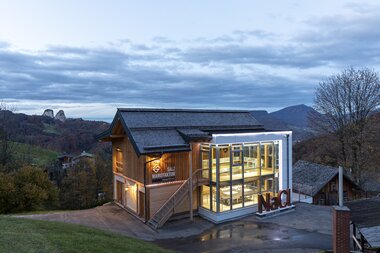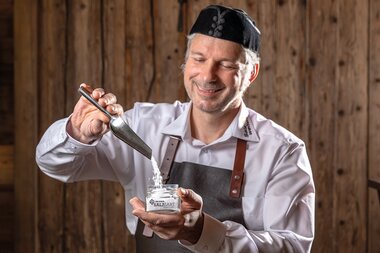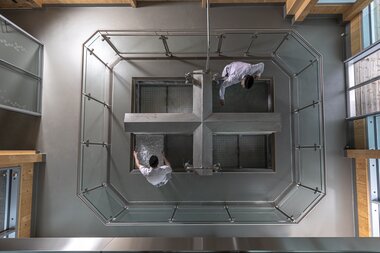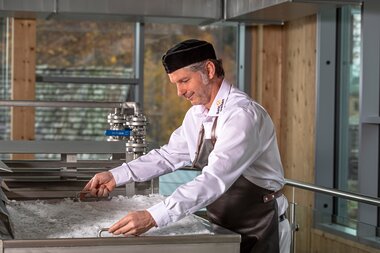The Salt Manufactory on the Dürrnberg Where delicate salt pyramids grow
After reemerging into the daylight after a subterranean tour of Salzwelten Salzburg, you should definitely set aside a little extra time for a side-trip to the Salt Manufactory. This out-of-the-ordinary blend of a wooden house and glass construction lies on the Celtic Mountain just a few steps above Salzwelten. The man-size letters NaCl out front give you a clear idea of what it’s all about on the inside: salt! In order to learn why part of the Salt Manufactory is made out of glass as well as what makes Salzzart so special, I met up with master salt maker Gernot Schuh at the Salt Manufactory and chatted with him about all kinds of salt-related matters.
“At Salzwelten Salzburg, for the first time it’s possible to experience the full story of salt production, from mining to manufacture of the finished product. There’s nowhere else quite like it in Austria!”
Tanja: Hello, Gernot! Thank you for taking time to talk with me and show me around the Salt Manufactory!
Gernot: Welcome to the Dürrnberg – or as we miners say: “Glück auf!”
Tanja: Gernot, first things first: When you look at the Salt Manufactory, the first thing that catches your eye is the big glass cube, which is quite a contrast to the wooden part of the building. Is there a special reason for it?
Gernot: It’s quite simple! This house is all about salt – or as it says in front: NaCl. Sodium chloride has a cubic crystalline structure. And that’s what the glass cube outside symbolizes. I’d just like to take this opportunity to add one important thing: The Manufactory isn’t here just for show. Every day we hand-make a product that meets the very highest standards of quality – known as BAD ISCHLER Salzzart. What makes Salzwelten Salzburg a really special place is the fact that, for the first time, it’s possible to experience the full story of salt production, from mining to manufacture of the finished product. There’s nowhere else quite like it in Austria!
Tanja: When you say “we” – whom do you mean precisely?
Gernot: I am referring to the “pan masters”. Which is a historical term that we decided to reintroduce. The pan masters ensure that, through the many different stages in the manufacturing process, the natural brine is transformed into a high-quality product – our Salzzart. My previous work experience in quality management was perfect preparation for this job: After all, what makes a good pan master is his or her propensity for perfection. Here, we don’t only produce a gourmet salt, we also create small pyramid-shaped works of arts.
Tanja: Pyramids? Now I’m confused. Weren’t we just talking about cubes?
Gernot: (laughs) No cause for confusion: Salt crystals are naturally cube-shaped. But our goal at the Salt Manufactory is to grow those salt crystals into small pyramids.
Tanja: Now, I knew that the Ancient Egyptians built their pyramids from rectangular blocks. But the fact that you are also creating pyramids here on the Celtic Mountain is news to me. How does it work?
Gernot: The basis for our Salzzart is brine. That’s to say, purest mountain spring water that flows through the rocks, washing with it the untouched salt of ancient oceans from deep inside the mountain. We then take this precious natural resource, which we are so fortunate to have available to us here, and turn it into an exceptionally fine food and seasoning product! The first step of that path: the brine comes into the first pan.
Tanja: Please excuse me for interrupting again … a pan!? As much as I try, I just can’t see a pan here.
Gernot: Yes, that’s right. You see, “pan” is a historical term. In earlier times, the salt was boiled out in big, round iron pans. But there you have a fundamental difference: Our brine is never boiled! We simmer slowly at a constant, moderate temperature.
“We simmer our salt, with a big pinch of time as an important ingredient – it would indeed be fair to refer to our product as ‘Slow Salt’.”
Tanja: How long does it take to get from brine to the finished Salzzart?
Gernot: Actually, almost two days. Firstly, we pour around 180 liters of natural brine into the first pan. As you can see, it’s a little cloudy. But after one day and one night, it has cleared and we divide it by hand into three other pans. That’s when we begin our “pyramid building”: As we simmer gently, tiny salt crystals form on the surface. These grow over time, with the edge of one salt crystal settling against the edge of another. This in turn creates small, hollow pyramids, which attach to one another and sink to the bottom. So, as you can see: If we were to boil the brine too quickly, those delicate pyramids would never have a chance to form. That’s why time is such a vital ingredient in manufacturing our “slow salt”.
Tanja: But how do you manage to get those fragile salt pyramids out of the pan?
Gernot: Yes, that is one of the most difficult steps, requiring lots of patience and a steady hand! Once the crystals are fully grown, the pan master raises the grille with the sunken salt crystals out of the brine. He slants it carefully and allows it to drain over the pan. Once again, the grille is tilted and allowed to drain. This is an important process, because the hollow cavities of the salt pyramids are filled with a solution containing bitter substances, which would spoil the taste of the salt later on. After draining off, the grille with the salt crystals is placed in the oven to dry for a few hours.
Tanja: And then the salt is finished, right?
Gernot: (chuckles) No, not quite. There are still a few important steps. The dry salt is now stroked by hand through a coarse sieve. In this way, the fragile pyramids which formed in the process of simmering and drying, are again separate from one another. This really demands a sensitive touch! And because salt is a pure natural product, it is never quite the same from one day to the next. True salt pros can taste, see and even hear the differences! Are the pyramids delicate enough? Do they drizzle or plop out of the jar? Are they transparent? Do they taste mild and delicate? Bottom line at the end of the day: Only salt that meets our quality standards with regards to look, touch and taste, will ever make it into a jar or salt mill.
“A regional product meeting the highest standards of quality – manufactured by hand from natural resources.”
Tanja: Wow! I would never have thought that so many steps went into making salt. But tell me: How can I make the best use of BAD ISCHLER Salzzart products?
Gernot: Our gourmet salt is mild in flavor, melts gently on the tongue and, with its unique “pyramid crunch”, is a perfect finishing touch to any dish: Simply sprinkle it over a juicy steak or grilled vegetables. Splendid! But even in combination with sweet foods, it creates an exciting flavor explosion of sweet and salty. You see: BAD ISCHLER Salzzart is the Austrian answer to French Fleur de Sel!
Tanja: Mmmmh, now I’m getting hungry! But one last question: Is it really possible to watch you and the other pan masters working your magic at any time?
Gernot: Absolutely! With the Salzwelten-Ticket, you can even visit Kelten.Erlebnis.Berg and the Salt Manufactory for free. And watch the pan masters go about their work daily, seven days a week – either peeking over their shoulders or looking down from the gallery above their heads, where, incidentally, you have a great view right down into the salt pans. Naturally, we are happy to give all visitors to the Dürrnberg the same explanation about salt pyramids as I am giving to you right now.
Tanja: Gernot, thank you again for introducing me to the fragile world of pyramid-shaped salt crystals – a really fascinating experience!
Gernot: You’re very welcome!
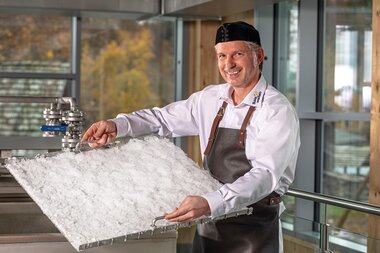
Gernot Schuh has been working at Salzwelten Salzburg for two years. A quality manager, mechanical engineer and tour guide, he has made a major contribution to the development of salt pyramids here on the Dürrnberg. You often encounter him close to the pans, though sometimes also inside the mine itself.
Special Tip:
So, have we whet your appetite? In that case, now’s a great time to buy your online ticket for a visit to Salzwelten Salzburg and the Salt Manufactory. And if it happens to be raining on the day you come? No matter! Salzwelten Salzburg is a perfect excursion destination even in bad weather!
Incidentally: Hand-scooped gourmet BAD ISCHLER Salzzart isn’t only available at the shops of Salzwelten Salzburg, but also at any time from our online webshop!
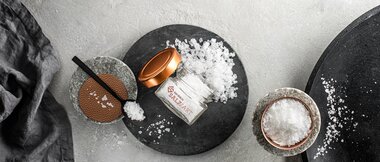
bad ischler
Salzzart
